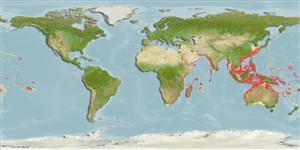>
Elopiformes (Tarpons and tenpounders) >
Megalopidae (Tarpons)
Etymology: Megalops: Greek, megas, megalos = great + Greek, ops = appearance (Ref. 45335).
Environment: milieu / climate zone / depth range / distribution range
生態学
海; 新鮮な水; 汽水性の 底生の漂泳性; 両側回遊性; 深さの範囲 1 - 50 m (Ref. 86942). Tropical; 34°N - 37°S, 16°E - 130°W
Indo-Pacific: Persian Gulf (Ref. 68964), Red Sea and Natal, South Africa (Ref. 3969) to the Society Islands, north to southern Korea, south to the Arafura Sea (Ref. 9819) and New South Wales. Restricted to high islands (Palau, Caroline and Mariana islands) in Micronesia. Reported as far inland as the lower Shire in Malawi and the Save-Runde junction in Zimbabwe (Ref. 7248, 52193). Widespread in the Lower Zambezi River channels up to Marromeu and in the Micelo River up to Malingapanzi (Ref. 39494). South China Sea, Taiwan Strait, and East China Sea(Ref.33302).
Length at first maturity / サイズ / 重さ / 年齢
Maturity: Lm ?, range 25 - ? cm
Max length : 150 cm TL オス/雌雄の選別がない; (Ref. 1479); common length : 30.0 cm SL オス/雌雄の選別がない; (Ref. 7017); common length :45.5 cm SL (female); 最大公表体重: 18.0 kg (Ref. 13337); 最大記録サイズ: 44 年 (Ref. 72487)
背面の脊椎 (合計) : 0; 背鰭 (合計) : 16 - 21; 肛門の骨: 0; 臀鰭: 23 - 31.
Obligate air-breathing (Ref. 126274); Adults are generally found at sea, but young inhabit river mouths, inner bays, and mangrove forests. In freshwater, they occur in rivers, lagoons, lakes, and swampy backwaters (Ref. 2847, 44894). Tolerate a wide pH range (5.2-9.1) (Ref. 44894) and salinities from 0 to 100. Mainly diurnal (Ref. 7017). Predaceous, feeding mainly on fishes and crustaceans (Ref. 5213). Breed offshore, possibly throughout the year. Larvae are transparent and resemble larval eels (Ref. 13337), but with a forked tail (Ref. 167). Juveniles commonly enter freshwater (Ref. 44894, 48635) in clear or turbid water (Ref. 44894). Known to breath air, rising regularly to the surface to do so. Cultured in ponds, the fry being sourced from the coasts (Ref. 7050). Popular angling fish (Ref. 3969). Edible but not esteemed (Ref. 3969). Caught by gill nets, seines, and trawls, and by hook-and-line; marketed fresh and dried salted (Ref. 10982).
Life cycle and mating behavior
成熟 | 繁殖 | 放精 | 卵 | 生産力 | 幼生
Whitehead, P.J.P., 1984. Megalopidae. In W. Fischer and G. Bianchi (eds.) FAO species identification sheets for fishery purposes. Western Indian Ocean fishing area 51. Vol. 3. [pag. var.]. FAO, Rome. (Ref. 3463)
IUCNのレッドリストの状況は (Ref. 130435: Version 2024-1)
Human uses
水産業: 少数商業の; 水産養殖: 商業; ゲームフィッシュ: はい
用具
特記事項
XMLをダウンロードして下さい
インターネットの情報源
Estimates based on models
Preferred temperature (Ref.
123201): 19.8 - 27.6, mean 24.4 °C (based on 501 cells).
Phylogenetic diversity index (Ref.
82804): PD
50 = 1.0020 [Uniqueness, from 0.5 = low to 2.0 = high].
Bayesian length-weight: a=0.00741 (0.00528 - 0.01040), b=3.07 (2.97 - 3.17), in cm total length, based on LWR estimates for this species (Ref.
93245).
栄養段階 (Ref.
69278): 3.5 ±0.1 se; based on diet studies.
回復力 (Ref.
120179): 手段, 1.4年~4.4年の倍増期間の最小個体群 (Assuming tm<=4).
Prior r = 0.57, 95% CL = 0.37 - 0.85, Based on 2 data-limited stock assessments.
Fishing Vulnerability (Ref.
59153): Very high vulnerability (90 of 100).
Climate Vulnerability (Ref.
125649): High to very high vulnerability (75 of 100).
Nutrients (Ref.
124155): Calcium = 44.8 [26.3, 77.6] mg/100g; Iron = 0.672 [0.410, 1.048] mg/100g; Protein = 17.1 [14.3, 19.7] %; Omega3 = 0.217 [0.122, 0.396] g/100g; Selenium = 71.1 [41.2, 135.1] μg/100g; VitaminA = 15 [6, 33] μg/100g; Zinc = 1.06 [0.78, 1.46] mg/100g (wet weight);
